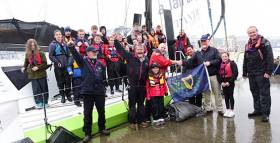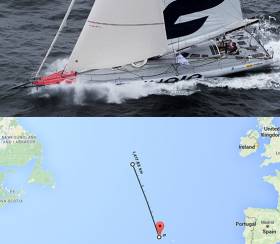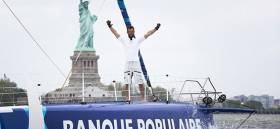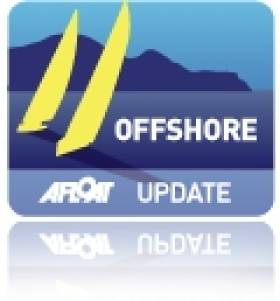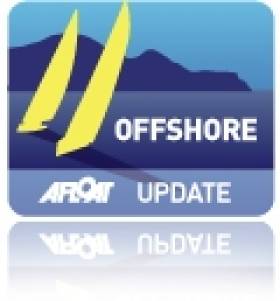Displaying items by tag: IMOCA 60
Enda O'Coineen & Cruising Association Give Fair Wind To Sea Scouts
Ireland’s first-ever Vendee Globe entrant, Enda O'Coineen with his IMOCA 60 Kilcullen Voyager, was in his home port of Galway this week for the presentation to First Port of Galway Sea Scouts of a cheque towards the renovation of one of their boats at Galway docks. Rasa is a 24–ft sailing cruiser which has been put back into service through a work programme over the past two seasons by an enthusiastic group of leaders and young scouts under the leadership of Alan Delaunty and Kieran Oliver. The boat, entirely crewed by the young scouts, participated in the Annual Blessing of the Bay last Sunday.
The presentation was made on behalf of the Cruising Association of Ireland, which has about five hundred members around Ireland. Clifford Brown, CAI Commodore, says they are delighted to contribute to such an excellent project giving training in sailing and seamanship to young people in Galway, and hopes the Rasa would next year be able to join one of the local CAI cruises.
The presentation was made aboard Kilcullen Voyager shortly before Enda O’Coineen set off a training session of four hundred miles out into the Atlantic prior to his single-handed handed Vende Globe challenge, starting on 6th November from Les Sables-d’Olonne in the Vendee region of Biscay France. Before departure for this week’s venture, he told the young Sea Scouts that he started his sailing in their troop back in the 1960's under Captain Whooley.
Abandoned IMOCA 60 Yacht. It's Red & White & 60ft Long. Ireland Please Keep A Look Out!
British sailor Richard Tolkien (61), one of the competitors in the race from Plymouth to New York, abandoned his yacht '44' and boarded the Cargo Ship ANTON TOPIC on Friday. Tolkein, who sustained head injuries in the abandonment, say it is his intention to recover the boat that is currently believed to be in a location nearly nine hundred miles north west of the Azores.
“I had to leave the boat which has a tracker on it – not an easy situation - and I hope to rescue the boat he said after the ordeal.
Locating the boat will not be easy according to Kinsale based Marcus Hutchinson who co-ordinated and recovered another abandoned IMOCA yacht last January. Hutchinson and a team set out from West Cork and rescued the SMA sponsored IMOCA Yacht last January.
Hutchinson told Afloat.ie he wasn't sure if the boat would make it into Irish waters: 'it is a lot further south and west and the weather is a bit different at this time of year so would take a lot longer. Also, I think the tracker, which is yellow brick, won't last for more than a couple of weeks', he said.
The movement of the yacht depends on the rig set up and what sails are still flying. It is unlikely to reach Ireland on the basis of current alone as it’s too far south and as it moves east there is a southerly element to the ocean current so it will probably end up moving south on the Canary current.
However, like SMA, the sail set up could promote sailing and more than counteract current if there is a south westerly and if it is more wind influenced it could “sail” in a north easterly direction – if it did this at 5 knots, it would be 300 hours or around two weeks before it got to the Irish coast.
Le Cleac’h Puts a Marker Down for Vendée Globe
He is known as the Jackal in French sailing because of his relentless competitive zeal and Armel Le Cleac’h lived up to his name with an impressive win in the IMOCA 60 class of The Transat bakerly today – his first victory in the class in 10 years. It puts the French man as favourite for the non–stop single handed round the world Vendee Globe race that will have its first ever Irish competitor when Enda O'Coineen races on November 6th.
Le Cleac’h’s elegant blue and white monohull, Banque Populaire, with its trademark dark blue sails, crossed the finish line under clear blue skies off Sandy Hook at 11:27 local time – 16:27 CET.
The two-time Vendée Globe runner-up had completed the 3,050-nautical mile course from Plymouth in 12 days, 2 hours and 28 minutes and 39 seconds. His total time includes a 31-minute penalty for the accidental breakage of his boat’s engine seal. Le Cleac’h informed the Race Director about this at 16:26 local time yesterday.
The French skipper had sailed a total of 3,751 miles through the water at an average speed of 12.91 knots. As he crossed the finish line, waving in his moment of victory to his shore team on their coach boat, Le Cleac’h’s main rival for line honours in the IMOCA 60 class, Vincent Riou on PRB, was 31 miles out to sea.
Ever since day three, as the leading IMOCA’s surged westward after turning to starboard at Cape Finisterre, Le Cleac’h has kept Riou at bay and covered his every move.
This was a fascinating battle between the foiling Banque Populaire and the more conventional hull on PRB as two of the favourites for this year’s Vendée Globe went toe-to-toe. In the end, it was as Le Cleac’h was docking his boat at Brooklyn Bridge Park, that Riou was crossing the line, just 2 hours, 21 minutes and 32 seconds behind him.
Riou reported earlier today that 24 hours after the fleet set sail from Plymouth on 2nd May, he lost two of his sails overboard, which forced him to rethink his tactics and routing for the race.
The Transat bakerly showed us two things. One, that even without two of his most important sails Riou can mix it with the best of the foilers, and two, that Le Cleac’h has a boat that is robust enough to deal with a full Atlantic storm. Just two days ago he said this race had given him the confidence he needs in his new rocketship to take on the Vendée Globe in it.
Speaking at the dockside, Le Cleac’h said he was delighted to take his first win in the IMOCA 60 class for a decade.
“I am very happy,” he said. “Ten years ago I came into the IMOCA class and this is the first time I have won. I have finished second a lot of times – in the Vendée Globe, The Transat, the Transat Jacques Vabre and the Route du Rhum, so today is a new day for me. I now I hope to be the first in the Vendée Globe.”
He paid tribute to Riou: “Vincent is a very good competitor. He has won all the races over the last year and he was favourite at the start. It was a pleasure to do this transatlantic race, because every day I could see Vincent behind me, and I said to myself, ‘OK, this race is for me.’”
Asked about his new boat, Le Cleac’h commented: “The foiling boat is a good choice. Last year it was the first year with this boat and we had some little problems and we didn’t have good speed.
“But now, we make a statement. And I hope it is the best boat for the next Vendeé Globe and I that I proved it during this race. So I am very happy for me, for Banque Populaire and for this very nice boat.”
Behind Riou the third-placed IMOCA 60 is Jean-Pierre Dick’s St Michel-Virbac which is still 138 miles from New York and expected to arrive at midnight tonight. Then comes Paul Meilhat on SMA who has been using The Transat bakerly as a qualifier for the Vendée. He still has 343 miles to go to reach the finish.
Two other IMOCA 60 skippers have failed to complete the course. Seb Josse on Edmond de Rothschild, retired mid-way through day two after the battens in his mainsail were damaged during a gybe. And yesterday Britain’s Richard Tolkien was forced to abandon his yacht 44, 880 nautical miles west, southwest of Horta in the Azores. After struggling with technical issues and sustaining an injury to his head, Tolkien has been taken on board the cargo ship Anton Topic which is bound for Philadelphia.
In the four-boat Multi50 class, Gilles Lamiré (Frenchtech Rennes St Malo) is less than 30 miles from the finish line, and is expected to arrive by 17:30 local time this evening, with a 320-mile advantage over Lalou Roucayrol (Arkema).
Trading places at the top of the Class40 fleet are Thibaut Vauchel-Camus (Solidaires en Peloton–Arsep), and Phil Sharp (Imerys). Earlier today, Isabelle Joschke (Generali-Horizon Mixité) officially announced her retirement from The Transat bakerly, after discovering serious damage to her boat’s structure yesterday. She is now en route to Saint-Pierre-et-Miquelon in Newfoundland.
Track the race here.
PROVISIONAL STANDINGS
The class rankings at 20:00 BST - updated every four hours
ULTIME
1. François Gabart/Macif - 8 days, 8 hours, 54 minutes and 39 seconds at sea
2. Thomas Coville/Sodebo - 8 days, 18 hours, 32 minutes and 2 seconds at sea
3. Yves Le Blevec/Actual - 10 days, 12 hours, 15 minutes and 59 seconds
IMOCA 60
1. Armel Le Cléac’h/Banque Populaire - 12 days, 2 hours and 28 minutes and 39 seconds
2. Vincent Riou/PRB - 2 days, 4 hours, 50 minutes and 11 seconds
3. Jean-Pierre Dick/St Michel Virbac - 138.nm to the finish
MULTI 50
1. Gilles Lamiré/French Tech Rennes St Malo - 34.8nm to the finish
2. Lalou Roucayrol/Arkema - 350.50nm to the leader
3. Pierre Antoine/Olmix - 763.50nm to the leader
CLASS40
1. Thibaut Vauchel-Camus/Solidaires en Peloton-ARSEP - 910.6nm to the finish
2. Phil Sharp/Imerys - 16.13nm to the leader
3. Louis Duc/Carc - 64.81nm to the leader
O'Coineen's Kilcullen Voyager Moves Into Third Place in Transat Race
Having started a day late and trailed the fleet by 300 miles, debut Irish IMOCA 60 skipper Enda O'Coineen has moved up into third place as the seven boat fleet pass the Azores. O'Coineen now has a potential finsih time of as soon as this Sunday.
The fleet leader, Sebastien Josse, is already finished with a dominant display. On crossing the finish line off the Linuen Est mark, at the entrance of Port la Foret harbour, this Wednesday 16 December, at 20hr 18mn 17s GMT, the skipper of IMOCA60 Edmond de Rothschild won the transatlantic race in style after dominating proceedings from beginning to end, only giving up the head of the race for the first six hours to SMA skipper Paul Meilhat.

His race time is 10d 05hr 18mn 17s. and his average speed along the great circle route (3,375 miles) equates to 13.76 knots. He covered some 3773 miles over the ground at a speed of 15.38 knots. In so doing, he qualifies for the Vendee Globe 2016.
Meanwhile, on Kilcullen Voyager, O'Coineen sent Afloat.ie the following update:
Being honest, I was scared. Through the early morning, it blew up to 40 knots – I ran off before it. The waves trundled after us, sometimes as high as double-decker busses and predictable like the 7A - However it’s the odd rogue wave, against the flow - that catches you unaware.
Eventually last night’s storm abated. I dozed off to sleep and awoke about 90 minutes later. The miserable grey dawn had arrived - like a black and white movie – now the days are so short they morph into the night that it's hard to tell the difference. The wind had dropped back to 15 knots. Like getting a thrill being the very last on a plane, or doing something that’s against the rules - its living on the edge which brings the kicks - and somehow I am not sure if that’s healthy, even if I have survived, so far as my hairs get greyer.
This morning, I had three tasks on sunrise. Which order was the issue. One being my ritual bow of porridge, the other a sail change and a the third to have a dump - though the least said about this the better. However I should reference one, seldom mentioned fact - which in my humble view has revolutionized ocean racing – it is the arrival of the biodegradable plastic bag and wipes – not invented when I was a lad.
Anyway, I went for the sail change first. This involved dragging the large headsail on deck and other preparations. Then when ready to go I had my porridge – which was just as well, since within an hour the wind was backup to 25 knots plus, so I abandoned the sail change.
Now my mood has moved to survival. Not much succour for romance and poetry. Overhead the rain pounds like pellets, I have never seen as much in one dump from the heavens. From tropics, through autumn and now winter, we have had three seasons in 10 days - so Spring must be just around the corner? Could it be Port La Foret?
Rankings on 16 December at 22h (UTC) and ETAs in Port-la-Foret
1. Edmond de Rothschild, Sebastien Josse: Finished on 16 December 2015 at 21h 18' 17" - Winner in 10 days 5h 18' and 17"
2. Newrest / Matmut, Fabrice Amedeo, 818.3 nm. ETA potentially Saturday 19/12 am
3. Currency House Kilcullen, Enda O'Coinnen, 1098.0 nm. ETA potentially Sunday 20/15
4. Le Souffle du Nord, Thomas Ruyant, 1128.4 nm
5. O Canada, Eric Holden, 1190.2 nm
6. Safran, Morgan Lagravirre, 1210.5 nm
Abd. SMA, Paul Meilhat
O'Coineen's IMOCA 60 Kilcullen Voyager Makes Gains in Transat Fleet
He started with a 24 hour disadvantage due to engine problems but after a week at sea Irish solo sailor Enda O'Coineen has hauled himself back into the Transat St Barth – Port la Foret race and now trails the fleet by only 55 nautical miles. In seventh place, the Galway Bay sailor is closing in on Canada's Eric Holden. It's been a great debut performance for the IMOCA 60 Kilcullen Voyager and it looks like there will be more gains for the Irish yacht due to the injury of the fleet leader. Paul Meilhat is currenlty awaiting airlift by helicopter.
Yesterday, Meilhat was seriously injured during a manoeuvre. At the time, IMOCA60 SMA was sailing downwind under mainsail alone and two reefs, around twenty miles to the south-west of the Azores archipelago, in 50 knots of wind and 8 metre waves. Paul immediately contacted his team to alert them about the incident: he has pain in the ribs, the hip and the right leg.
Race Management for the Transat Saint-Barth / Port La Forêt and the MRCC in Ponta Delgada (Maritime Rescue Coordination Centre) were alerted straightaway. Initially, Paul and his team decided to find 'shelter' for the boat in the lee of the island of Sao Miguel.
At 15:30 GMT, when Paul confirmed that he was having considerable difficulty moving himself around the boat, the emergency services were triggered. The patrol boat from the Portuguese navy, Viana Do Castelo, heads to the zone. However, the weather conditions are such that it is not possible to envisage an airlift by helicopter or a vessel to come alongside in the immediate future.
SMA is currently barepoled and is drifting offshore at around 6 knots, escorted by the navy patrol boat, which will remain alongside him throughout the night. Paul is in permanent contact with his team and with the medical department in Lorient, Brittany.
Today, Tuesday, once the low currently plaguing the zone around the Azores has shifted over to the East, the weather conditions will improve and Paul can be airlifted by helicopter. SMA's team is on its way and will be in Sao Miguel at around lunchtime local time tomorrow, Tuesday.
#Open60 - There was plenty of action on the water in and around Cork Harbour this afternoon (Sunday 12 July) as the Atlantic Youth Trust's IMOCA 60 Kilcullen Voyager took on the Alex Thomson-skippered Hugo Boss in a special challenge race as part of this weekend's SeaFest events.
Indeed, it's not every day Cork Harbour plays host to not one, but two of the world's highest performing ocean racing yachts - particularly one with a record-breaking offshore pedigree, and the other sailing with youth sail trainees taking up a once-in-a-lifetime opportunity to get on-deck experience at sailing's pinnacle.
Despite the relative lack of experience on the Irish boat, they certainly gave Thomson and crew a run for their money today, closing a significant gap to cross the finish line only a minute or so behind the professionals.
Hugo Boss well ahead of Killcullen, currently about 3 miles south of Roches Point @Seafest_ie pic.twitter.com/aW1L51l0Mm
— Gavin Deane (@gavinroyalcork) July 12, 2015Alex Thomson Explains Dismasting Incident That Took Hugo Boss Out Of Barcelona World Race
#BarcelonaWorldRace - "One of the most painful experiences of my sporting life" is how Alex Thomson describes the dismasting incident on the IMOCA 60 Hugo Boss that took him and Alex Pepe out of the Barcelona World Race.
As previously reported on Afloat.ie, the pair were in the lead of the global two-man-crew offshore challenge when they lost their rig on Wednesday evening (14 January) some 370 nautical miles off the Brazil coast.
Speaking from the South Atlantic yesterday (15 January) en route to Salvador, Brazil, Thomson outlined exactly what happened on board their monohull.
“At about 9pm Pepe and I were doing a sail change in 18 knots of wind. As we dropped one of our headsails, the furler broke and flew into the air.
"For a few seconds the mast hovered, before falling backwards and into the water. Pepe reacted quickly and we cut the rest away, losing the mast, boom and rigging.
"Of course we are devastated and disappointed. As offshore ocean racing sailors this is a peril of our sport, but it is still painful."
Though the pair are now out of the race, their focus is entirely on attempting to "assess and analyse the problem and learn from this, but we will remain ever determined and resilient to come back stronger and succeed.”
See more on this story at the Alex Thomson Racing website HERE.


























